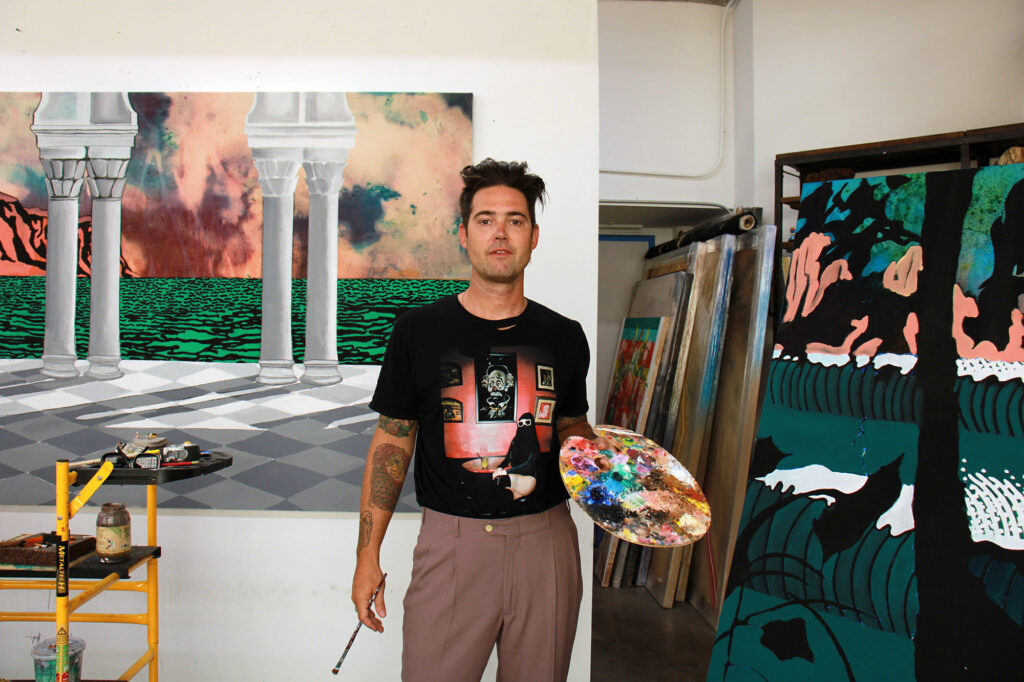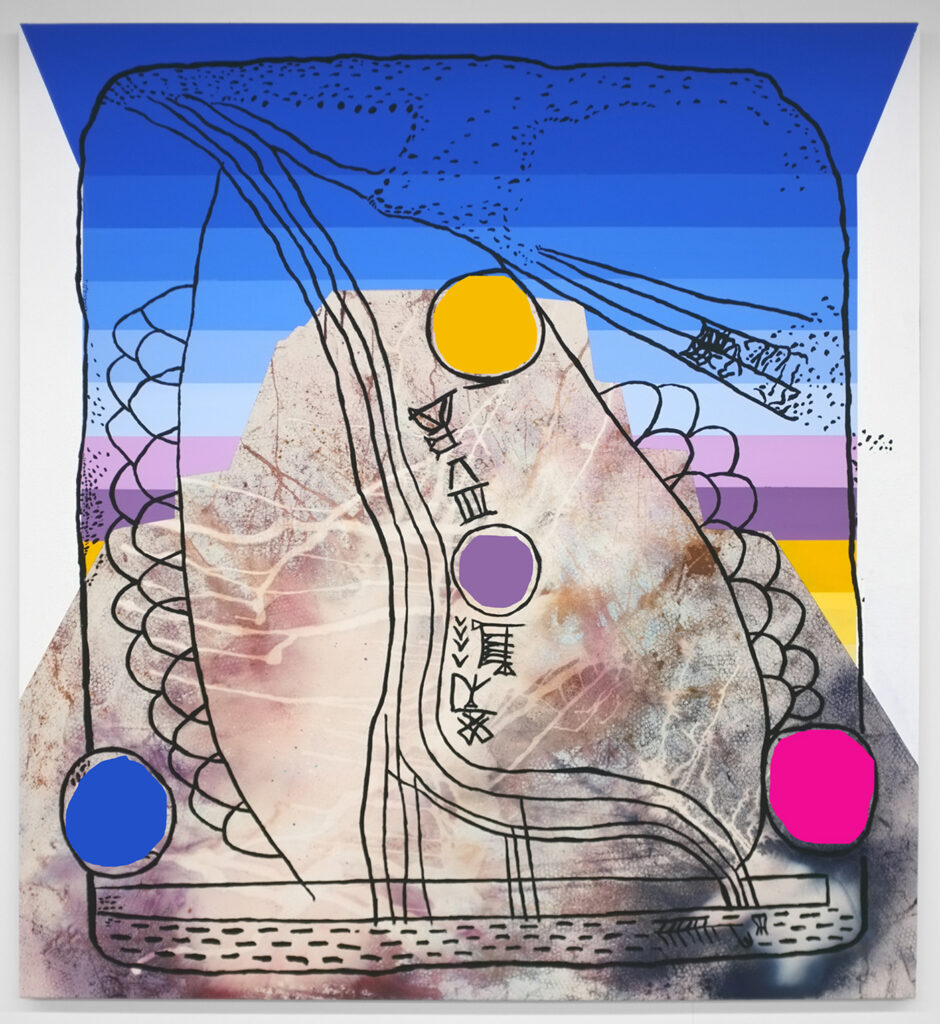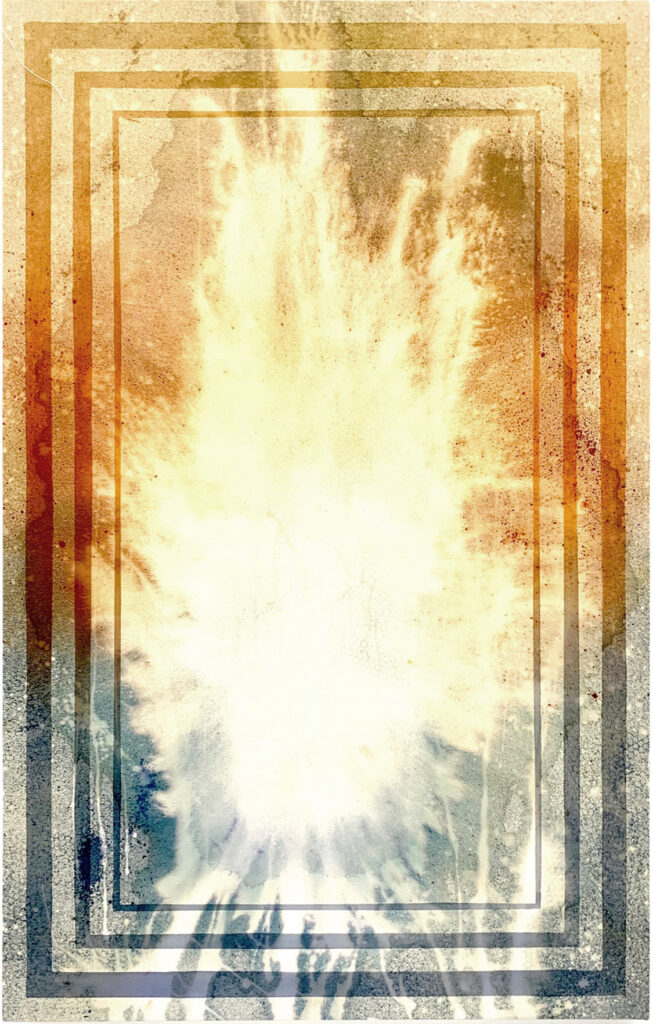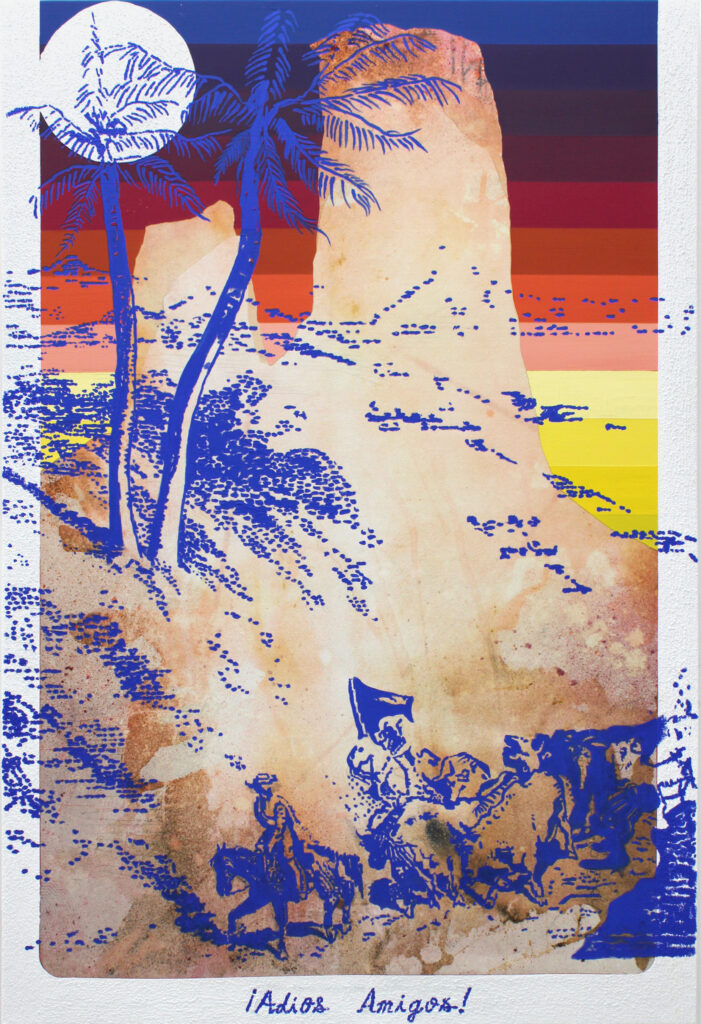August 24, 2021
Artist to Watch
THEODORE BOYER

NB: What are your earliest memories of interacting with or experiencing art?
TB: I think it was when I was really little, probably my youngest son’s age — four years old. I grew up in Orange County, just south of Los Angeles, in a suburb. My cousin and Grandmother lived in Morro Bay. When we would come up to visit them, we would drive through Los Angeles up the 101. I would see the murals [created for the 1984 Summer Olympic Games] by the Disney Building. It’s the same murals there now as in the 1980s. It’s amazing. In Glenna Boltuch Avila’s L.A. Freeway Kids, there are these little kids and there is one playing basketball. On the other side, there is the mural of Lita Albuquerque, from Kent Twitchell’s 1983 7th Street Altarpiece, across from a work by Jim Morphesis. It’s amazing, and it really stuck with me. As a little kid, I was wondering — what is that?! I ‘got’ the murals and the things that were more obvious — like graffiti — but that piece really stuck me.
NB: Let’s talk a little bit about your work. What are the different themes you explore, regarding identity, belonging, sense of place? Can you talk about how these influence your work?
TB: I was adopted, and that plays a role in my identity issues. I hadn’t really known who my [birth] parents were for a really long time; I never really knew where I came from. It never really struck me, until I started creating art (and talking to my therapist) that these were serious, deep-rooted things that I needed to explore and deal with. Throughout the last 10 years, since I’ve been seriously making art, I have been going back to this theme of death and rebirth. It is an ancient, ‘as above, so below,’ masculine feminine alchemical thing that really, to me, starts at birth and ends at death. The way that I have worked is by starting with abstract paintings that represent various primordial things — focusing on the background in the abstractions — then moving into more common themes like evolution, for example, or astrology or astronomy.

NB: How did you become inspired to incorporate science and nature so centrally in your creative practice? Could you also speak to the different series that you’ve been working through?
TB: Science and nature have always been a part of my practice. I’ve always gone back to the ideas of spirituality, reflecting on the cosmos and the primordial being, the origins of humanity, and evolution. I worked in the abstract for a while, dealing with cosmology, astronomy; looking at stars and thinking about navigation. As it evolved, over the last couple of years especially, I have been moving into more figurative work. This transition has stemmed from my personal experience; my personal journey through life.
NB: I can tell from your work that you’re very interested in the history of painting. Who have you been looking at, in art history, that has influenced the different series of your work?
TB: I am always looking at art and artists. Many, many different artists (and things!) influence me: Sigmar Polke, German Expressionism and Alice Neel, [David] Hockney, Marlene Dumas among others. The artists that I am influenced by have such a wide range — just thinking about the contrasting practices of Alice Neel and that of Robert Smithson. There is so much art that goes into my subconscious and gets cycled around, and then translates into my little formulas that I have when I paint.
NB: Can you speak to those formulas a little bit?
TB: I start out with the abstraction. That comes from different imagery of space explosions, chaos and cataclysms. I have several books in my studio where I collect inspiring images to have them constantly visible and circulating, so I keep them in my subconscious. I’m constantly looking at various things. I have a vast library too. I am always looking at images that reference what I’m painting — even the abstractions. I use that as a background then I move into different techniques. Right now, I’m working on mostly figurative pieces. Essentially, I’m collaging the ideas together.
NB: Could you speak to your series Rainbow Cataclysm? Do you have other projects coming up, or new series that you’re working on?
TB: The Rainbow Cataclysm is, again, a sort of collage of my acquired tropes from over the years. The real core concepts are: human origins, death, and rebirth, which are the overarching topics that I deal with in most everything that I create. Like ‘the chicken or the egg,’ everything starts at some point, right?
Things culminate in one moment, then die, then come back — possibly as another thing? That is the on-going theme. I’m looking at flowers, I’m looking at still lifes; I’m looking at things that decay and devolve. I am also looking at the human experience, as well. These flashes of time that happen over the course of eternity. What I’m exploring in Rainbow Cataclysm is a subconscious flashback, in many ways. The idea of a cataclysm, in and of itself, is that every civilization comes to an end at some point, and then it’s reborn and turned into something else. Those concepts exist on a macro level and also on a micro level. I’m working on the microcosm of this experience now. I’m looking at organic matter that decays over time; the human condition; relationships; things that start, blossom, and come to an end — in one way or another.
I have a couple of upcoming projects. One is a show in Hong Kong called Techno Lust that is curated by Ben Lee Richie Handler and staged at W.O.A.W. Gallery which I’m putting together right now. It’s a group show, and I’m doing an installation. Some of my Star Map paintings will be presented as wallpaper, covering a whole room — in a psychedelic way — then paintings will be hung over it. I will also show a couple of paintings, alongside many cool artists. That show will be at the end of August. Then, I am going to Istanbul for a residency at Sevil Dolmaci Gallery in mid-September where I will also be exhibiting paintings for a show curated by Dr. Kathy Battista. I’m very excited about that! In the first week of October, I’ll be in Crete for another residency at Elounda Island Villas. The residency is run by a Greek artist named Leda Alexopoulou. I was introduced to her through Viennese curator Anne Avramut – who has a background in archaeology. She contacted me about my new still life paintings. Being that the flowers are painted in these different Greek, Etruscan and Minoan pots, Anne thought it would be cool to connect me with Leda and experience Greek culture and history first hand. With Covid, everything has been locked down for the last few years. This will be the first or second time I’ve been on a plane. It feels like things are getting back to normal a little bit. Hopefully, new art will flow again! Prior to the Star Maps series I had been working on figurative paintings — it was mostly dealing with narratives surrounding history, ancient cultures and archaeology. I was super lucky to have studied in New York and Zurich, where I had access to some of the most amazing museums and collections in the world. During those years I was able to catalogue artifacts and relics that would appear in my work much later. Although in the past five years I’ve been exhibiting mostly abstract paintings, I was also painting small figurative studies for my own enjoyment. It wasn’t until a couple of years ago that I would publicly show them.

NB: Did you find that the time during the pandemic greatly influenced your work, and the type of work that you produced? Did it change the type of work that you produced? Or were you just trying to just survive, with two kids at home?
TB: Yes, I mean, honestly, going back to the studio was like my sanctuary. I felt really fortunate to have had the studio space, and to have been able to keep it. At that time, I had been working with several galleries and I then went completely independent. Around the same time I was having somewhat of a personal crisis, which I also feel very fortunate to have come out of. After that, I started making work that was more related to what I was dealing with, right then and there, such as the loss of personal relationships and friendships. I also looked at my family; my wife and kids — using them as my muses — and portraying them in my work, which I had not done before and that was a big reckoning for me.
It was a confirmation of the things that really do influence me, and my life, all the time; they need to be in my work at this point! I also started painting portraits of friends of mine — people that I hadn’t seen in 6 or 8 months. Until then, we had just been following each other on Instagram, and making do. Usually, I would have people come over to my studio, and invite people who I would want to paint, and do a portrait from life. Since the pandemic began, I wasn’t able to do that. Most people were worried about Covid, and it was just too much for a lot of people. Instagram was really the only outlet to look at art; all the museums were closed. All the galleries were closed for that period too, so I looked to the internet, collecting images; putting together these image archives. I was also painting portraits of people who posted their pictures on Instagram.
NB: Definitely, it’s the way to connect in the absence of human connection. Back to figuration!
TB: Exactly, back to figuration! Now, I am still working on the Star Maps and abstractions, but I am also bringing people into the studio now and doing portraits from life which always keeps things exciting.


